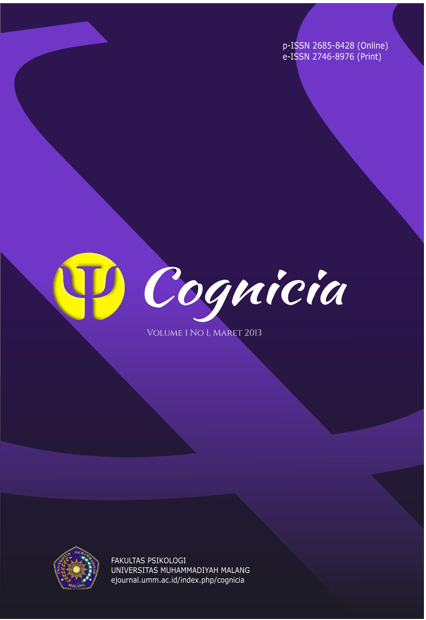KONFLIK INTERPERSONAL KARYAWAN PT.PLN (PERSERO) RAYON RANTAU YANG DIPIMPIN OLEH MANAJER JUNIOR
DOI:
https://doi.org/10.22219/cognicia.v1i1.1456Abstract
Penelitian ini merupakan penelitian deskriptif kualitatif. Subyek penelitian ini berjumlah 5 orang yaitu 1 orang manajer dan 4 karyawan. Metode pengumpulan data menggunakan wawancara semiterstruktur. Analisis data dilakukan dengan cara pengumpulan data, reduksi data, penyajian data, dan penarikan kesimpulan (verifikasi). Hasil penelitian menemukan bahwa dari 4 subjek penelitian, 2 orang subjek sedikit mempermasalahkan dipimpin oleh manajer yang berusia lebih muda karena manajer yang berusia muda cerdas dalam menganalisa pekerjaan serta mempunyai visi dan misi yang bagus untuk kemajuan perusahaan. Sedangkan 2 orang subjek lainnya mempermasalahkan dipimpin oleh manajer junior karena berusia muda dan pengalaman kerja masih kurang. Konflik interpersonal yang terjadi antara karyawan dan manajer junior disebabkan karena masalah pengalaman kerja, faktor persepsi mengenai perencanaan(plan) manajemen logistik dan faktor komunikasi mengenai komunikasi vertikal, yakni Komunikasi manajer kepada karyawan, dankomunikasi karyawan kepada manajer. Strategi manajemen konflik yang dilakukan dengan 2 cara, yaitu The Teddy Bear (Smoothing) konflik harus dihindari dan memilih sikap mengalah agar hubungan tidak menjadi rusak demi keharmonisan.
Kata kunci: Konflik interpersonal, Manajemen konflik interpersonal, Manajer junior
The research is a qualitative descriptive research. The subjects of the research are 5 people, which are 1 manager and 4 employees. Data collected by semi-structured interview. Data analyzed by data collection, data reduction, data presentation, and inference (verification). The result of the research showed that of 4 subjects, 2 are less problematic with the younger manager leadership on the reason that the younger manager have intelligence in job analysis and have a good vision and mission to improve the organization. 2 other subjects have a problem because the junior manager in their view too younger and have less work experience. Interpersonal conflict occurred between employee and junior manager caused the factors: work experience, perception on planning, logistic management, and vertical communication that is communication between the employees and the junior manager and vice versa. Conflict management strategy that is implemented are 2 kinds, The Teddy Bear (Smoothing) strategy in which conflict avoided by pretend to lose so the relation is not broken and harmony created. In this strategy, the employees obedient and do what the manager asks them to do.
Keyword: Interpersonal conflict, Interpersonal conflict management, Junior manager
Downloads
Downloads
Published
How to Cite
Issue
Section
License
Copyright (c) 1970 Sri Rahayu

This work is licensed under a Creative Commons Attribution-ShareAlike 4.0 International License.
Authors who publish with Jurnal Cognicia agree to the following terms:
- For all articles published in Jurnal Cognicia, copyright is retained by the authors. Authors give permission to the publisher to announce the work with conditions. When the manuscript is accepted for publication, the authors agree to automatic transfer of the publishing right to the publisher.
- Authors retain copyright and grant the journal right of first publication with the work simultaneously licensed under a Creative Commons Attribution-ShareAlike 4.0 International License that allows others to share the work with an acknowledgment of the work's authorship and initial publication in this journal.
- Authors are able to enter into separate, additional contractual arrangements for the non-exclusive distribution of the journal's published version of the work (e.g., post it to an institutional repository or publish it in a book), with an acknowledgment of its initial publication in this journal.
- Authors are permitted and encouraged to post their work online (e.g., in institutional repositories or on their website) prior to and during the submission process, as it can lead to productive exchanges, as well as earlier and greater citation of published wor (See The Effect of Open Access).

This work is licensed under a Creative Commons Attribution-ShareAlike 4.0 International License







